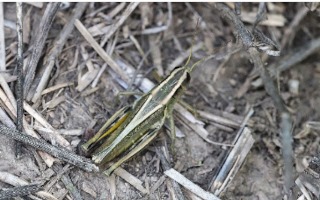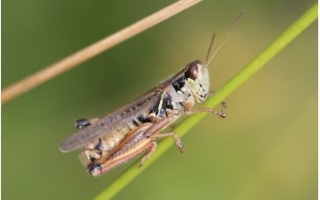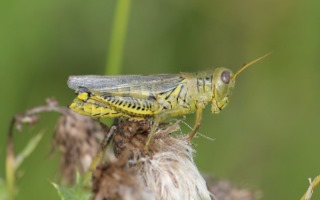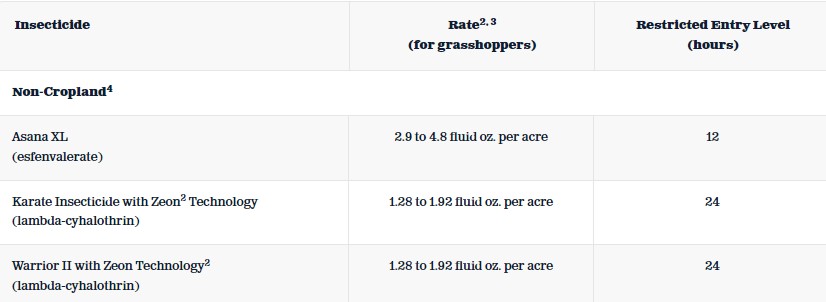By Adam Varenhorst and Philip Rozeboom et.al
Originally Submitted: August 31, 2023
Throughout much of the state, 2023 grasshopper populations have been problematic due to increased population densities and dry conditions. Many of these grasshoppers will be present until the first hard frost, which means they could cause issues for newly emerging winter wheat, as other food availability will continue to decrease through the fall.
Populations of Concern
Most of the grasshopper populations have consisted of twostriped (Figure 1) and differential (Figure 2) grasshoppers. However, redlegged grasshoppers are also present, but at much lower densities than the other two species in most areas (Figure 3).
TWO-STRIPED

Figure 1. Two-striped grasshopper adult. Courtesy: Adam Varenhorst
REDLEGGED

Figure 2. Redlegged grasshopper adult. Courtesy: Adam Varenhors
DIFFERENTIAL

Figure 3. Differential grasshopper adult. Courtesy: Adam Varenhorst
Scouting and Management
As winter winter begins emerging, it is important to monitor field edges for grasshopper activity and feeding injury. This is especially true in areas where large populations have been observed throughout the summer. Newly emerged winter wheat is a very attractive host to grasshoppers and can suffer stand loss due to grasshopper feeding. Field edges are the hardest hit areas, because the grasshoppers often reside in road ditches or nearby crops. Monitoring fields and determining grasshopper densities before and after planting can prevent large populations from causing stand losses shortly after the winter wheat emerges.
PRIOR TO PLANTING
Before planting, scout the vegetation around the field edges and count the number of grasshoppers that are present in approximately one square yard. Management should be considered if 11 to 20 grasshoppers per square yard are present in the non-crop borders.
Management options to consider include:
- Delaying planting: Delay planting in areas where grasshopper populations are high to reduce the time that grasshoppers will be feeding on the emerging wheat.
- Increasing plant stands: In areas with increased grasshopper population densities, winter wheat planting population can be doubled in a 60-to-120-foot-wide strip around the field edge. As grasshoppers move into the field, they will feed on the emerging wheat. However, the increased plant stands around the edge will slow the movement of the grasshoppers into the rest of the field. The increased plant stand will compensate for the lost seedlings and allow for a reasonable stand to exist after grasshoppers have finished foraging for the year.
- Insecticide seed treatments: Insecticide seed treatments are labeled for grasshopper management in winter wheat and can provide protection during emergence by deterring feeding. For grasshoppers, treated seed can be planted along field edges in a strip that is 60-to-120-feet wide, or it can be planted to the entire field. For effective management of grasshoppers, the highest registered rate of the product should be applied to the seed. Please refer to the latest South Dakota Pest Management Guide - Wheat for insecticide seed treatment options and recommended rates.
- Foliar insecticides: Foliar insecticide sprays may be applied to the non-crop field edges to prevent the grasshoppers from moving into the wheat fields. Before selecting an insecticide, check the label to ensure that it can be sprayed on non-crop areas. See Table 1 for a list of non-crop and pasture insecticide options.

AFTER PLANTING
If grasshopper populations are causing severe defoliation or clipping in newly emerged winter wheat, it is important to determine if their populations are above 8 grasshoppers per square yard. Additionally, determine how far into the field the grasshopper populations are.
When grasshoppers are only present around the field edge, a foliar insecticide application to that area may be sufficient for reducing feeding pressure. It is important to remember that there will be residual activity of the foliar insecticides due to the limited leaf area of emerging wheat. Please refer to the latest South Dakota Pest Management Guide - Wheat for a list of foliar insecticides that may be applied to wheat.
If injury to the field edge is severe due to heavy grasshopper feeding pressure, it is possible to replant those areas after the first hard frost occurs. At this time, grasshopper populations will have declined significantly.
Source : sdstate.edu